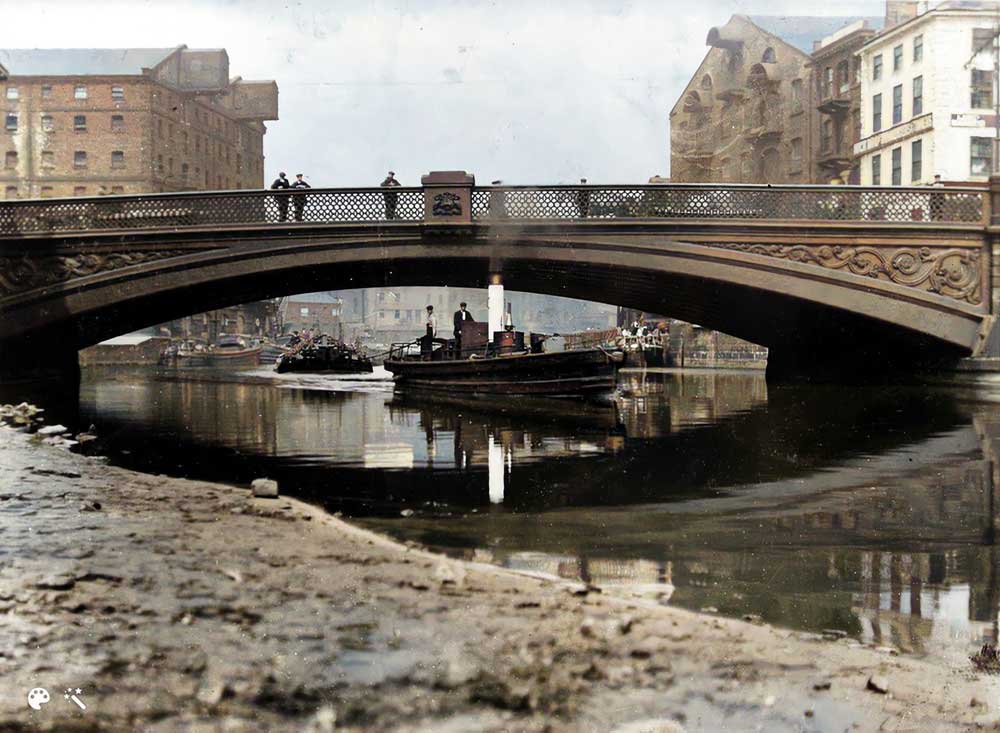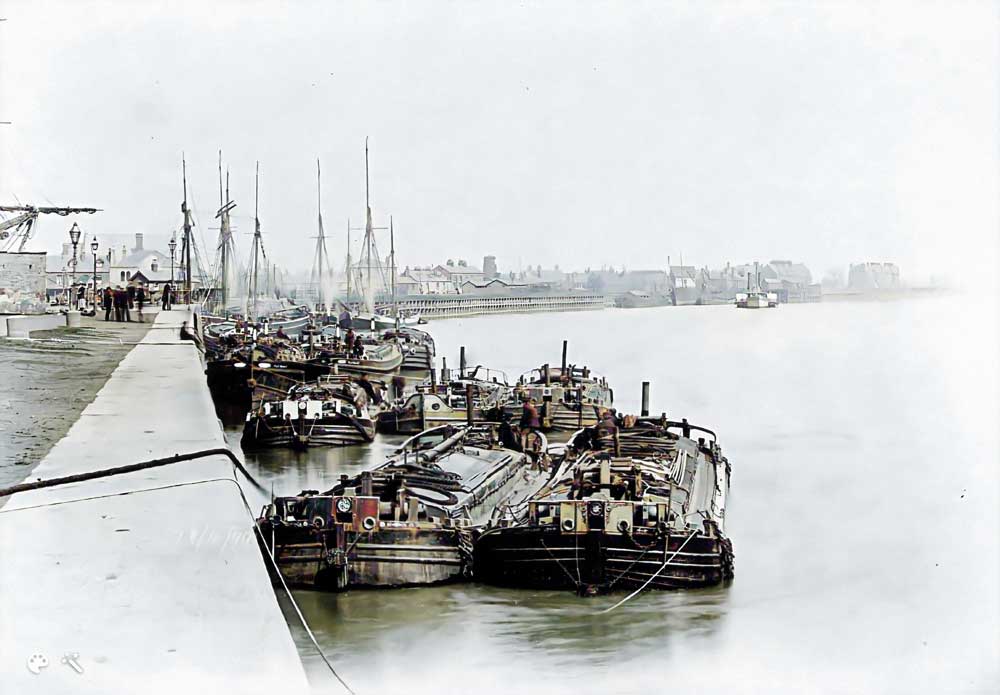Getting inside knowledge of boatmen’s work
A black, irregular bulk, standing out in sharply cut relief against a sky where the moon dodged in and out between drifting cloud banks. Here and there, a light blinking out of the darkness. That was Leeds.
Black water at my feet, and behind, a great dim building where spluttering arc lights cast long, mysterious shadows among the bales and barrows piled beneath. That was the dock.
A bent figure carrying a lantern, and another huddled in a trench coat, shivering in the damp morning breeze. One was the watchman. The other, myself. Alternately he told me tales of soldiering in India, ‘way back in the ’70s, and threw pebbles on to the deck of a tug lying at the wharf.
Scene : The canal docks, Leeds. Time : 4.00 am.
Ultimately the pebbles produced the desired effect. A very sleepy head came up out of a hatchway, and the owner of the head inquired the time. Then it disappeared. Soon, however, another head took its place and a body followed. The figure, a shapeless mass in the dim light, stumbled along the deck, and vanished down another hatchway.
Almost immediately, there followed queer rumbling sounds and a prolonged hissing. Little waves splashed against the wharf, as the boat rocked in time to the engine.
“Better come on board,” the first head called to me as it reappeared from the hatchway. “We’ll be getting away soon.”
I jumped down upon the deck. The thud of my feet seemed to be a signal for the whole crew to come on deck. There were three of them – captain, mate and engineer. They were too busy to talk, so I dumped my haversack upon a coiled hawser, and looked about me. The moon had fled in the early morning light, and the black bulks on the canal had gradually resolved themselves into fly boats.
They too were beginning to show signs of life. A boatman or two appeared on deck, exchanging remarks with each other and with the tugmen. I saw a woman’s head protruding from a hatch. She regarded me sharply, wondering, no doubt, what I was idling there for. A man came forward with a long boat hook and began pushing the barge away from the wharf. The boat swung out into the stream, and floated slowly off.
The tug shook as the propeller began to turn. The water roared at the stern, giving off an odour that made me wish for my old gas mask. The canal water in the Leeds district is an awful compound of weird smells. An industrial chemist would feel quite at home here.

The Voyage Begun
We were off now, winding in and out among the barges. Some of the latter were moving with us, smoke coming out of the chimneys in their bows, where their crews were making their morning cup of tea. Others still slept. The morning wind was cold, and I went below to “chum up” with the engines. When I came on deck again, we were in the first locks.
From Leeds to Castleford there are five locks, all rather small. We had five barges in tow, and our string had to be sent through each lock in two “pens”, as the canal men call them. First the tug and two fly boats went through the locks. While we waited below, the lock filled again, and the three others followed after us.
The speed of a tow depends upon the number of boats in the string. Besides retarding the speed of the tug, the small size of the locks often necessitates cutting the tow into as many as three “pens”, which, of course, involves long waits at each lock.
“Why do you call them “fly boats”?” I asked the captain of the tug, as we cleared the first lock.
“Because they fly”, was the laconic answer. “They look slow, but before the war we used to leave Leeds at night and be in Goole early in the morning, ready to catch the tide in the Ouse. The boats would be in Hull in about twenty hours after leaving Leeds. If coal was the cargo, it was sent down in forty ton compartments. At Goole and Hull are giant cranes which pick up the compartment bodily out of the river, and dump the whole forty tons into a steamer”.
“What cargoes do we carry?” “Any sort of goods, just as the railways do. There’s a boat back there – that red one with a pump in the centre of the hatch – which is filled with tar. It’s being sent to France or Belgium, where the tar will be used to make the patent fuel they use over there”.
Slowly, we steamed down the river, gradually drawing out of Leeds. Once we passed a coal barge towed by a horse. It was reminiscent of the old tow-path days. Between Leeds and Castleford, said the captain, there are still a number of horses used, but they are being superseded by the more efficient steam tugs.
Until we reached Castleford, the country was uninteresting. Had it not been for the boatmen and their tales of canal life, I should have been very much “fed up”. We floated along through a flat monotonous country, relieved here and there by a colliery and the villages where the pitmen live.
From Castleford, the land assumes a different character. The level country gives place to low hills, gradually becoming higher as we near Goole. The mines disappear, and on either bank are rolling meadows and little stretches of wooded country.
We had dinner in the tiny cabin of the tug, and as we ate the men told me something of their life on the canal. Eight hour day devotees will probably be shocked to learn that the tugmen work from fourteen to fifteen hours a day. They’re up at four o’clock in the morning, and seldom get in before six or seven pm. There are no half holidays for them. Even on Sundays they come down to the boat to overhaul the engine, and clean up things generally.
The captain apologised because, he said, the boat was not as clean as it should be. I’ve seen dining-rooms which were a lot more in need of cleaning. I had always thought that canal boats were dirty affairs, but I know better now. If my (hypothetical) wife keeps my home as clean as that boat, I’ll not worry.
Knottingley, which we passed in the middle of the afternoon, is a picturesque old village, with crumbling walls where flowers bloom and birds make their nests.
At one time, Knottingley was a seaport. “Billyboys”, ketch rigged vessels with round sterns, sailed from there, and the captains and mates lived in the high gabled houses along the river. Great rusty iron rings, let into the walls, showed where the “Billyboys” had once been moored.
We came into Goole at 7 o’clock the following day, and there ended the first stage of the trip. The tug would go back to Leeds next morning, but the fly boats would go through the locks and into the Ouse to wait for the tide.

High tide came about ten the following day, and we were off for Hull. This time I travelled in a sea-going tug, which towed two strings of four barges each. Like the canal tug, this boat was spotlessly clean, and the captain and crew did all in their power to make the trip pleasant.
Down the Humber
They told me of the treacherous channel of the Humber, where the sands shift with every tide, and of the vessels that had been wrecked on their way up the river. They showed me the “made land” below Swinefleet – land dredged up from the bottom of the river and dumped on to the banks at either side, behind piles and stone walls.
The primary object was to make the channel narrower, so that the current would flow more swiftly and cut away the deposit of silt brought in from the sea. But some of this new land makes excellent salt meadows, where we could see farmers making hay.
Near Whitgift are great stretches of mustard, glowing yellow in the sunlight.
“On a rainy night”, chuckled the captain, ”we don’t need lights to tell us when we are near Whitgift. We can smell those mustard flowers for two or three miles”.
We came to the junction of the Ouse, the Trent and the Humber – a magnificent stretch of water where the farther banks are hidden in the mist.
From there down to Hull we zig-zagged back and forth, following the tortuous windings of the channel. In the middle of the afternoon, we came in sight of the Fish Docks, the first of the five mile line of docks which stretch along the water front at Hull. Numerous trawlers were drawn up on the ways, and as we steamed past the Victoria Dock, we could see the masts of some American standard ships – those vessels which were all built to one pattern like Ford cars. They had just returned from Germany, and were stopping at Hull to fill their bunkers for the homeward trip.
We caught glimpses of dozens of fly boats crowded into the basins, and an occasional small schooner stranded on a mud bank by a receding tide.
Our tug leaped forward suddenly, and I saw that six of our barges had cut loose and were on their way to join the throng lying in the basins. A little farther down, our remaining two cast off their hawser, and we scooted down the harbour free.
Alexandra Dock loomed up in front of us. Everywhere were great travelling cranes, looking like some of H G Wells’s Martians as they straddled along over the railway tracks.
The bell in our engine room jingled. The propeller stopped. We swung in and bumped against the side of the pier. Our journey was over.
